Morphological Description
Life History
Distribution
Habitat
Roost Sites and Roosting Patterns
Emergence and Flight Pattern
Foraging Behaviour
Echolocation Calls
Status and Protection
|
|
Morphological Description
- Dorsal fur has an even medium to dark brown colouring. Ventral fur is silvery or brownish grey. Fur is of an even length.
- When irritated, the bat holds its ears folded so that they are held almost at right angles to the head.
- Posterior edge of tragus is convex. Tragus is longer than it is broad.
- Calcar is three quarters of the length from foot to tail.
- Average weight (as given by Greenaway & Hutson, 1990) 6-12 g.
The diagram below gives important average body measurements for Daubenton's bats as given by Greenaway and Hutson (1990). |
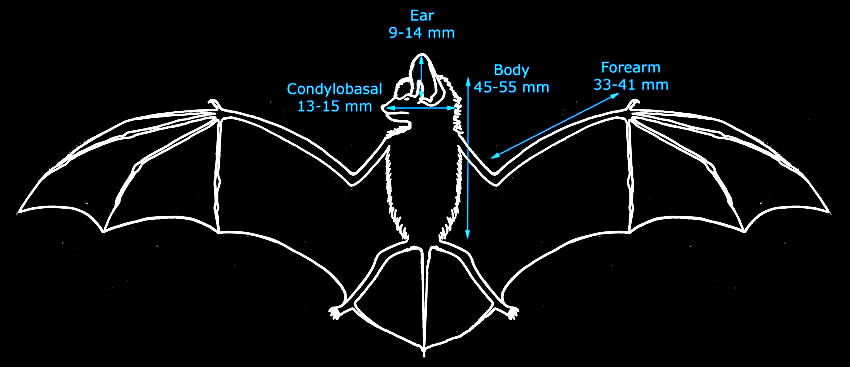
Back to top |
Life History
- Mate from September through to April.
- Gestation period is usually 5-7 weeks but the precise timing is weather dependent (Speakman, 1991). In Europe one young is born in June or July (Schober and Grimmberger, 1989).
- Maximum age recorded in Britain is 18 years (Speakman, 1991) but on average Daubenton's bats in Europe only live 4-4.5 years (Schober and Grimmberger, 1989).
Back to top |
Distribution |
|
|
 |
The British and World distributions of Daubenton's bat are shown by the white areas of the maps above (as given by Richardson, 2000 and Corbet & Harris, 1991 respectively).
Common throughout England and Wales. Populations are more dispersed north of the Lake District (Speakman, 1991).
Back to top |
Habitat
|
|
- Daubenton's bats are found close to calm water in open wooded areas.
- The most common habitats found around Daubenton's bat roost sites in autumn were parkland, woodland and open-water (Parsons & Jones, 2003).
- Vaughan et al. (1997) found that Myotis bats inhabited a wide range of habitats, particularly rivers and lakes, but were never in villages.
- The photograph on the left shows a typical habitat of Daubenton's bats.
|
|
Roost Sites and Patterns
|
- Summer roosts: In Europe nursery roosts are found from May to August (Schober and Grimmberger, 1989) and usually contain 20-50 females (Greenaway & Hutson, 1990). May form aggregations with other species such as pipistrelles, brown long-eared bats and Noctules. Roost in hollow trees, buildings or under bridges. Daubenton's bats in The Netherlands show a preference for oak trees over beech trees, and prefer to roost close to woodland edges (Boonman, 2000). This may minimise their energy expenditure in flying to their feeding sites.
- Winter roosts: Daubenton's bats are usually solitary in winter and found in crevices in caves and similar environments between August and April.
- Rarely found in bat boxes.
- Daubenton's bats in Switzerland were found to use up to seven day roosts all within one forest, which they visit on average every other day. Males change roosts twice as often as females. The bats are more likely to change roosts after rainfall (Rieger, 1996).
Back to top |
Emergence and Flight Pattern
|
Multiflash photographs of a foraging Daubenton's bat (1/15th second between each image).
Click on the image below to view an enlargement.
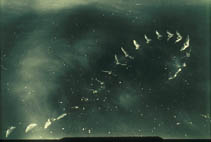
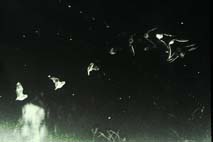
Back to top
|
- Median emergence time is 84 minutes after sunset (Jones & Rydell, 1994).
- Flies close to the water surface.
- Fast, agile fliers with high speed wing beats.
- Bartonicka & Zukal (2003) assessed seasonal and overnight changes in flight activity of Daubenton's bats. Daubenton's bats are more active in the post-lactation period than the lactation period.
- Jurczyszyn & Bajaczyk (2001) studied the emergence patterns of Daubenton's bats in western Poland. They found that females were more likely to emerge at the start of the night than males. It was also found that body mass of emerging bats tends to increase as the night proceeds.
- Jones & Kokurewicz (1994) investigated sex-related wing morphology differences in Daubenton's bats. Female Daubenton's bats had a larger average wingspan and wing area than males. This sexual dimorphism in wing shape may impact the flight behaviour of males and females.
|
Foraging Behaviour
|
|
- Forages 2-25cm above open water and occasionally along woodland paths but rarely within 2m of vegetation (Russ, 1999).
- Daubenton's bats were found to be most active near water bodies (Bartonicka & Zukal, 2003).
- Rydell, Miller & Jensen (1999) found that Daubenton's bats foraging over water will concentrate on calm areas and avoid areas with ripples, a behaviour not explained by insect distribution. Further investigation found that ripples in the water surface are avoided as they produce significant interference with the returning echo of the bat's call.
- Boonman et al. (1998) found Daubenton's bats avoided foraging over ponds covered with duckweed. This behaviour is unrelated to prey abundance. Experimental evidence suggests that bats are less able to catch prey where there is duckweed cover.
- The diet of Daubenton's bats mainly consists of aquatic Diptera (Vaughan, 1997). Aquatic pupae are taken from the water surface and male Chironomidae can be caught as they swarm above the water surface waiting for females to emerge. Daubenton's bats forage mainly by trawling insects from calm lake and river surfaces.
- Siemers et al. (2001) found that Daubenton's bats in captivity can catch small fish with their feet if the fish penetrates a smooth water surface.
- Flavin et al. (2001) studied the diet of Irish Daubenton's bats. They found that their main prey was Chironomidae, other nematocercan Diptera and Trichoptera. A quarter of the prey was obtained from the surface of water.
- Prey is caught and consumed during flight.
- Forages up to 10km from roost (Speakman, 1991).
|
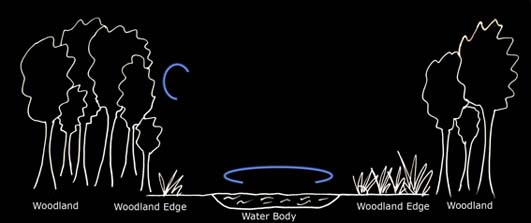 |
Marked in blue on the diagram above is a typical foraging path of Daubenton's bats (based on Russ, 1999).
Back to top |
Echolocation Calls
|
|
|
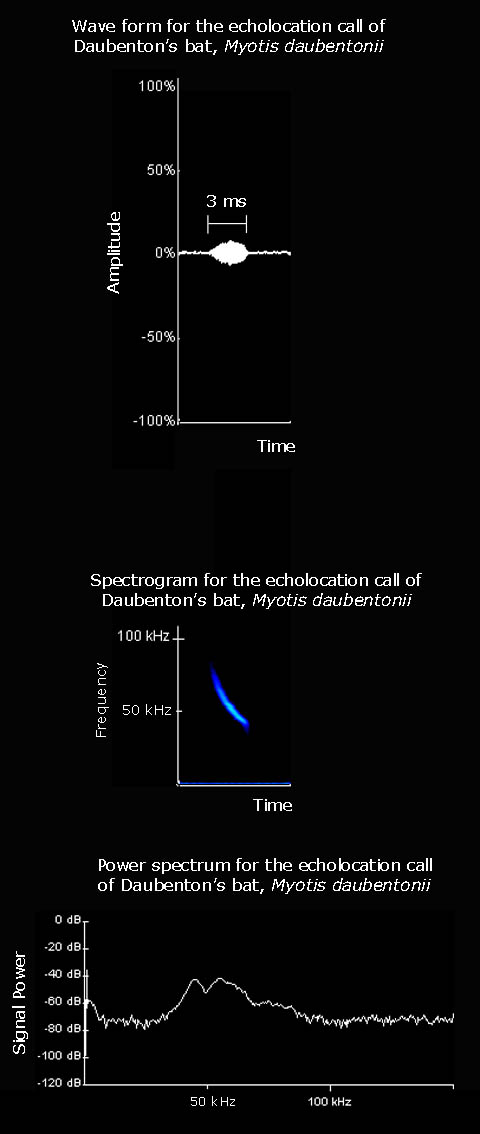 |
The echolocation call of Daubenton's bats is frequency modulated and sounds like short sharp clicks. |
To listen to the call of the Daubenton's bat click here
Size of sound file: 9.01 KB
For details of how the echolocation calls were recorded click here.
|

|
Average values for a Daubenton's bat echolocation call, as given by Vaughan et al. (1997), are listed below:
Interpulse interval: 69.8ms
Call duration: 6.2ms
Minimum frequency: 38.8kHz
Maximum frequency: 61.4kHz
The spectrogram on the left shows clear frequency modulation, with the call beginning at high frequency and ending at a lower frequency.
The power spectrum on the left shows that the maximum power of the call is at a freqeuncy of approximately 50 kHz.
There is some evidence that the echolocation call of Daubenton's bats can provide information about the success of the capture and the size of the prey (Britton & Jones, 1999). Parts of the call just before and after prey capture were found to be longer when the capture was successful.
|
Back to top |
|
Status and Protection
- Populations appear stable throughout Britain, possibly due to the conservation of habitats and lack of pesticides over water.
- The British pre-breeding population was estimated at 150,000 in 1995 (95,000 in England, 40,000 in Scotland and 15,000 in Wales ) (Harris et al., 1995).
- Daubenton's bats are not at risk of extinction worldwide (IUCN status, 2001).
- The decline in Europe of many bat populations, including that of Daubenton's bat is often partially attributed to the use of agricultural chemicals in the intensification of agriculture. The recent increase in the number of organic farms in the UK has facilitated comparative studies between organic farms and conventional farms (which use chemicals). A study by Wickramasinghe et al. (2003) found higher Daubenton's bat activity on organic farms than conventional farms.
- Daubenton's bats exhibit swarming behaviour at sites within 27 km of their day roost (Parsons & Jones, 2003). The swarming sites studied by Parsons and Jones had a minimum catchment area of 497 km squared and are probably important for outbreeding. Daubenton's bats generally use swarming sites in parkland, open water habitats and woodland. Daubenton's bats appear to be faithful to a single swarming site and so it is essential that these sites are conserved.
- Whitby et al. (2000) found the first case of rabies in a bat on 30th May 1996 in East Sussex in a Daubenton's bat. The wind trajectories from the previous days indicated that the bat may have originated from near the France-Swiss border.
- Fooks et al. (2004) reported the presence of antibodies to European bat lyssaviruses in Daubenton's bats. An 8% prevalence was found in bats from two sites where there was an ‘a priori' reason to expect the presence of the virus. The data from other sites in England and Scotland (where there was no ‘a priori' reason to expect a positive result) indicated a prevalence of 2% in Daubenton's bats. The presence of antibodies suggests previous exposure to the virus, not current infection. Other species were tested and no evidence of European bat lyssaviruses was found.
Back to top |
 © School of Biological Sciences, University of Bristol 2005. Last modified 24th February 2005. © School of Biological Sciences, University of Bristol 2005. Last modified 24th February 2005. |





 © School of Biological Sciences, University of Bristol 2005. Last modified 24th February 2005.
© School of Biological Sciences, University of Bristol 2005. Last modified 24th February 2005.